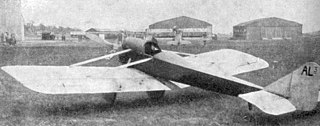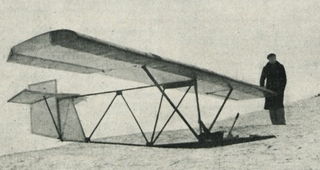Related Research Articles

The Levasseur-Abrial A-1 was a glider built in 1922 as a result of a collaboration between French aerodynamicist Georges Abrial de Péga and constructor Pierre Levasseur. A single example was built, which was destroyed on its fourth flight.

The 1923 Feiro I was the first Hungarian designed and built civil transport aircraft, modified in 1925 by an engine change into the Feiru Daru (Crane). Neither was a commercial success.

The Avia 41-P was a high performance French glider. Eric Nessler set many new national gliding records in one between 1934 and 1938.
The Avia 60-MP was a French motor glider with a wing based on that of the Avia 32-E, an advanced training glider. It was intended as both an advanced trainer and as an atmospheric research aircraft.

The Lachassagne AL 3 was an experimental 1920s French aircraft designed to test a camber-changing wing meant to extend speed ranges. It was flown only briefly but led to a second design with similar features.

The Lorraine-Hanriot LH.70 or S.A.B. LH.70 was a French trimotor designed to a 1930 government programme for a colonial policing aircraft. Only two were built.
The Peitz 101, aka Peitz Avionette, was a French amateur-built, all-metal light aircraft, first flown during the winter of 1931–32.
The Leduc RL-12 was a French low power, economical, parasol wing, single seat aircraft. First flown in July 1939, its development was halted by World War II.
The Bréguet Colibri was a low power, single seat French monoplane designed to compete in a 1923 newspaper-sponsored contest between such aircraft. Only one was built.
The Peyret Avionette was a low power, single seat French monoplane which won several first-place prizes at the Congrès Experimental contest of 1923.
The Marais avionette was a single seat, low-powered cantilever monoplane built in France in 1923 to compete in a newspaper-sponsored tour contest. Engine selection problems prevented it from taking part. It was modified into a glider for a later competition but crashed during qualification. It was one of the first aircraft to have a retractable undercarriage.

The Hanriot H.34 was a basic trainer designed in France in 1924 which did not reach production. It was a parasol wing aircraft, seating two in tandem.

The Dewoitine 14 was a mid-1920s French civil transport, capable of carrying mixture of passengers and freight. The sole example was used in commercial trials.

The Hanriot H.25 was a French, single-engined, six passenger airliner built in 1926. Only one was flown.

The Skraba S.T.3 was a two-seat Polish biplane built in 1928. It was the first all-metal aircraft designed in Poland; only one was completed.

The Peyret-Nessler Libellule (Dragonfly) was a French two-seat, low-powered parasol wing light aircraft built in 1927 to provide practical but economical flying. It was one of the first of these French avionettes.
The Bulté RB.1 was a Belgian training and touring biplane first flown in 1928. Five examples flew with clubs and with private owners in contests and rallies.

The Działowski D.K.D.1 was the first powered aircraft designed by Stanislaw Działowski. It was a low-power high-wing monoplane with a cabin for one passenger. After attending an aviation exhibition in Warsaw in 1927 it was badly damaged when the engine failed as it left and it did not fly again.

The Jaworski WJ 3 was a Polish, low-cost primary glider first flown in 1936. It did not prove popular and only one was built.
The PGE EV.1K Fecske (Swallow) was a high performance Hungarian sailplane designed and flown in the late 1960s. The sole example was destroyed in a fatal crash in 1970.
References
- 1 2 "The gliders". Flight . XVII (33): 522–524. 13 August 1925.
- 1 2 3 4 5 6 "Le planeur Abrial no. 2". Les Ailes (216): 1–3. 6 August 1925.
- ↑ "Le meeting de Vauville". Les Ailes (215): 2–3. 30 July 1925.
- ↑ "La vol à voile à Vauville". Les Ailes (247): 6. 11 March 1926.
- ↑ "Coups d'ailes". Les Ailes (254): 5. 29 April 1926.